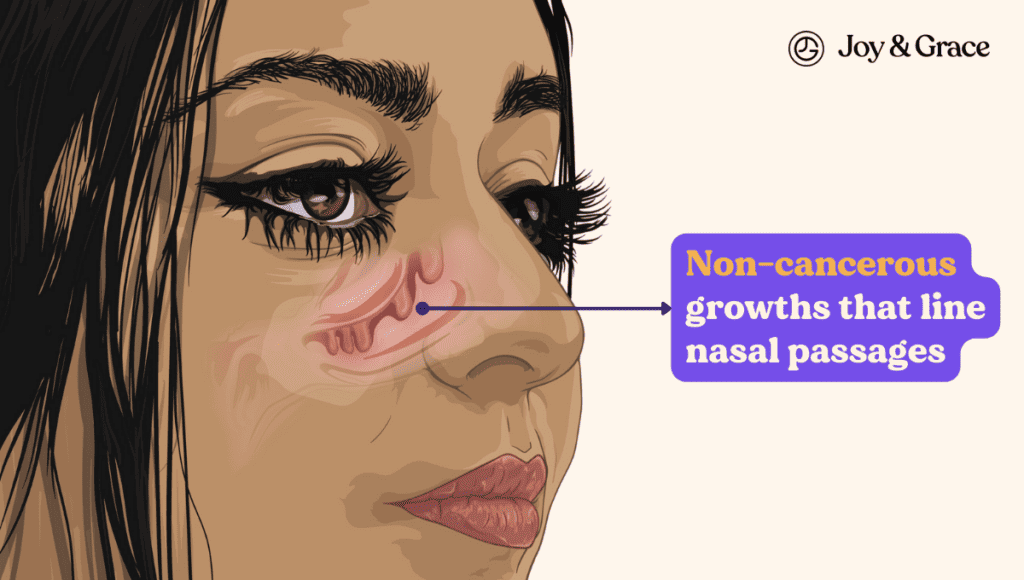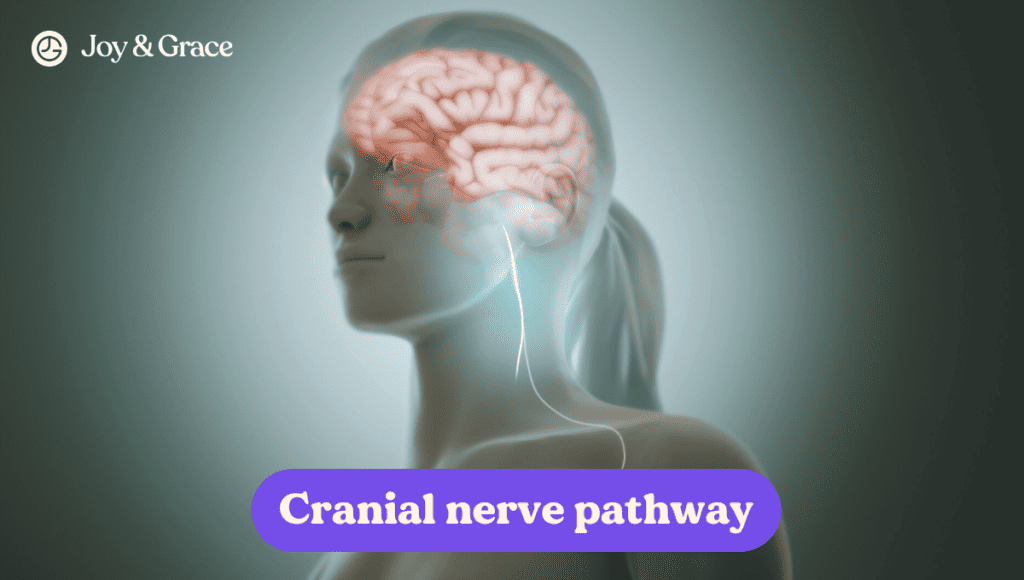Are you familiar with the ache in your neck and the stiffness that keeps you turning all night? Have you ever thought your persistent nasal issues could be the ultimate culprit? At Joy & Grace, we understand the complexity of human health, where seemingly unrelated conditions like sinus infections can manifest as neck pain.
This blog post will explain the connection between sinus infections and neck discomfort. Buckle up and read along with us to find out how a simple sinus infection can affect more than your nose and throat.
Can a Sinus Infection Affect My Neck?
Simply put, yes. As it turns out, sinus infections may affect the neck. Neck pain is a more unusual symptom of sinus infections.
But how do they reach the neck all the way from the facial area? To explain the hows behind this connection, let us first talk about paranasal sinuses and infections.
Paranasal sinuses are pocket-like spaces located in the face area. There are four types of sinuses, and they come in pairs:
- The frontal sinuses,
- The ethmoid sinuses,
- The sphenoid sinuses and
- The maxillary sinuses.
The frontal sinuses are located inside the forehead. The ethmoid sinuses are found in the upper nose, between the eyes. The sphenoid sinuses are deep-lying behind the nose. Maxillary sinuses are found inside both cheeks and on the sides of the nose.
So, what are the purposes of the paranasal sinuses? Well, sinuses have a few important functions. Here are the key ones:
- They produce mucus. Mucus is a gelatinous substance that filters out materials you breathe in through your nose. These materials can be dust, allergens, or microorganisms. Thus, it serves as a protective barrier by not allowing them to stay inside the body.
- Sinuses are normally filled with air. Air is light! So they also help in lightening the weight of the head.
Sinus Infection-Related Neck Pain and Stiffness
Now that we understand what sinuses are and what they do, let us get on with infections.
A sinus infection is marked by inflammation of the paranasal sinuses. Inflammation of the sinuses is also known as sinusitis. Sinus infections are common. They affect millions of people worldwide.
Sinusitis makes your sinuses produce more mucus than usual. More mucus means a thicker protective barrier and more congestion. More congestion leads to a runny and/or stuffy nose, facial pain, headaches, and, surprisingly, neck pain. But, how does the neck suffer from all this? Let us find out below.
Can a Sinus Infection Spread to Your Neck?
There are a few ways in which inflammation spreads from the sinuses to the neck. Here are the main mechanisms:
- Sinus infections can cause muscle tension and pain.
Sinus infections and the associated sinusitis may lead to muscle tension and pain. Muscle pains are also known as myalgia. This effect comes from the release of inflammatory cell substances called cytokines. These induce inflammation and cause muscle tension and pain. Neck muscles are not spared, either. Myalgia is common in patients with respiratory infections, affecting half of them.
Understandably, neck muscle pains can also make you stressed and tired. And surprise, surprise, stress is a major risk factor for neck pain.
Finally, myalgias can affect your sleep, too. All these factors may ultimately worsen your problem further and result in pain that spreads to the shoulders and back. - Sinus infections lead to more mucus production.
When the sinuses are inflamed, they produce excess mucus. The body tries to remove the excess mucus by swallowing frequently. Because so much of it is being produced, mucus starts building up in the throat. Frequent swallowing can cause strain and tension of the muscles in the neck and shoulder area. Mucus buildup in the throat can also lead to a sore throat and persistent coughing. These two add to the pain by damaging the throat lining.
- Sinus infections may indirectly cause neck pain by causing headaches. Studies suggest people with sinus headaches commonly report neck and shoulder pain.
“Sinus headache” is a popular term used to describe a headache from a nose or sinus disorder. According to a 2019 study, around 84% of patients with sinus headaches also reported associated neck pain. In 75% of cases, neck movements and posture changes worsened the headache.
Still, even though there is a high percentage of association, further research is needed to fully understand the connection between sinus infections, headaches, and neck pain. - Sinus infections can spread to the neck glands. Neck lymph glands, or nodes, are located in groups along the neck. With ongoing inflammation, such as that from sinus infections, they tend to swell.
The swelling of lymph nodes is known as lymphadenopathy. The swollen glands in the neck tell us that the immune system is fighting the infection. They usually return to their normal size once the infection clears.
The inflammation can also spread to the throat, causing a sore throat (a.k.a. pharyngitis). Pharyngitis may then result in neck pain.
Rarely, swollen lymph glands may indicate a more serious underlying problem. If you notice any size changes, make sure to check them out.
What Does Sinus Neck Pain Feel Like?
The type of neck pain may vary based on the underlying cause of sinusitis.
So, if the pain comes from increased muscle and joint tension, it may feel like discomfort and increased pressure. When lymph nodes are affected, the neck usually feels swollen and congested. Whereas in the case of pharyngitis, neck pain may come on as the burning feeling of a sore throat.
What Causes Sinus Infections?

What are the culprits behind sinus infections and sinusitis? Sinus infections are caused by microorganisms, primarihttps://livejoyandgrace.com/virus-that-causes-neck-painly viruses. Sinusitis, though, may also be caused by other factors.
Let us talk about the causes of sinus infections and sinusitis one by one:
- Sinus infections. Sinus infections happen when fluid builds up inside the paranasal sinuses. This fluid allows the germs to grow.
Most sinus infections are viral. Only a small number of people develop a bacterial infection. Rhinoviruses, influenza viruses, and parainfluenza viruses are the most common causes of sinusitis.
The most common bacteria isolated from bacterial sinusitis samples are the following: Streptococcus pneumoniae, Haemophilus influenzae, Moraxella catarrhalis, and Streptococcus pyogenes.
Viruses and bacteria are not the only sinus villains. Parasitic infections and fungal infections can also (more rarely) cause sinusitis. They appear, especially in patients with weakened immune systems (such as those suffering from HIV) and manifest with more severe symptoms.
- Allergies. Allergies represent another common cause of sinusitis. Allergy symptoms, such as congestion and sinus pressure, can also cause tension in the neck, leading to neck pain. Common allergens and irritants include animal dander, polluted air, smoke, and dust.
- Deviated septum. A deviated nasal septum is a condition where the wall that separates the two nostrils is off-center. This can block the sinuses, leading to pain in the face, head, and neck. Blockages like a deviated septum allow infections to grow by preventing drainage and airflow in the sinuses.
Nasal polyps. Nasal polyps are growths in the nasal passages that can block the sinuses and cause nasal obstruction. They can cause pain and pressure in the face and neck. Similar to a deviated septum, polyp obstruction increases the risk of infection.
An important note: Just because you have neck pain does not always mean you have sinusitis. Neck pain is a common musculoskeletal problem that can have numerous causes, such as:
- Muscle strain or sprain,
- Torticollis,
- Whiplash injury,
- Osteoarthritis,
- Rheumatoid arthritis,
- Bad posture, etc.
The Role of Nasal Polyps on Neck Pain: Can Sinus Polyps Cause Neck Pain?

Nasal polyps are non-cancerous growths on the lining of your nose or sinuses. They appear as a result of repeated irritation from the thick mucus or foreign agents. They are typically associated with symptoms like a runny nose or breathing issues.
But, as mentioned, nasal polyps may also cause sinusitis. They are often associated with chronic rhinosinusitis. Sinusitis, in turn, can lead to neck pain through one of the many mechanisms listed above.
Can Nerve Damage Cause Sinus Problems and Neck Pain?

Three special nerves mediate the functions of the paranasal sinuses. They include the following:
- The ophthalmic nerve,
- Maxillary nerve, and
- Vagus nerve.
All of these are cranial nerves. Sinus problems may arise if these nerves are damaged.
An interesting example of how damage to these nerves can occur is from problems with the cervical vertebrae and neck.
Unstable neck vertebrae or herniated discs may pinch the nerves. Thus, the impulses they carry may get blocked. As a result of this, sinusitis may appear.
Changes in cranial nerve function may also be caused by conditions other than neck problems.
These conditions include the following:
- Poorly controlled diabetes,
- High blood pressure,
- Head injuries,
- Infections,
- Strokes, and
- Brain tumors.
Any potential cranial nerve dysfunction requires prompt medical evaluation.
Understanding the Symptoms: Sinus Infections and Neck Pain
It has been said that neck pain is a more unusual sinus infection symptom. One characteristic of this pain is that it may spread. Neck pain may radiate to the throat, jaw, back of the head, shoulders, and back. Sinus neck pain usually goes along with the other symptoms of sinus inflammation. Let us see what they are.
What Are the Symptoms of Sinusitis?

The most common symptoms that hint at sinusitis include the following:
- Blocked nose,
- Pain and tenderness around the cheeks, eyes, and forehead,
- Sinus headache,
- Green or yellow discharge from the nose,
- Fever (100.4F or 38C or more),
- Toothache,
- Reduced sense of smell,
- Bad breath (halitosis).
Based on the duration of these symptoms, sinusitis may be classified as follows:
- Acute sinusitis: It starts suddenly and lasts less than four weeks with complete resolution.
- Subacute sinusitis: Symptoms last for 4-12 weeks.
- Recurrent acute sinusitis: Four or more episodes of acute sinusitis lasting at least seven days each in a 1-year period.
- Chronic sinusitis: Signs and symptoms persist for 12 weeks or longer.
How Do I Know if a Sinus Infection Has Spread to the Brain?

A sinus infection becomes serious and dangerous when it spreads to distant areas. One of these vulnerable areas is the brain. Inflammation may spread to the brain owing to its short distance from the sinuses.
Here are two severe complications that may result if sinus infections spread to the brain:
- Meningitis. If a sinus infection spreads to the brain, it can cause meningitis. Meningitis is an inflammation of the membranes that surround the brain and spinal cord. This inflammation can lead to severe headaches, a fever, and a stiff neck. In some cases, it can even cause a seizure, coma, or death. Meningitis is a serious medical condition that requires immediate attention.
- Abscesses. An abscess is another potential complication of a sinus infection that spreads to the brain. This is a collection of pus that forms in the brain tissue. A brain abscess causes severe headaches, fever, seizures, weakness, or paralysis of one side of the body. It also leads to changes in mental status, such as confusion or disorientation.
- Cavernous sinus thrombosis. Cavernous sinus thrombosis involves the formation of a blood clot.
It is a potentially life-threatening condition. The clot is initially created as a protective barrier against the spread of bacteria. However, it may also block venous blood flow to the brain and increase the pressure inside the skull. Cavernous sinus thrombosis can cause headache, eye swelling, vision problems, and numbness or weakness on one side of the face. Sinus thrombosis may also lead to blood infection or sepsis.
People most at risk of suffering from a severe sinus infection that spreads include:
- Those who do not get the proper treatment for their sinus infection.
- Those with a weakened immune system (people suffering from HIV/AIDS, cancer, or diabetes).
When to See a Doctor for Symptoms Related to Sinus Infections and Neck Pain

Is there a certain time when you should be worried about your sinus neck pain? Do the sinusitis symptoms that we mentioned earlier sound familiar?
If you haven’t had sinus symptoms before, you might be in doubt about what you should do. If you think you might potentially have sinusitis, consult your doctor. You’ll receive early treatment (if necessary) and remove any worries you might have had. If you’re familiar with sinusitis, on the other hand, here is some advice on when to see a doctor:
- Your symptoms are severe or get worse
- Painkillers do not ease the pain
- Your symptoms do not improve after one week
- You keep having repeated bouts of sinusitis
Seeing a doctor will provide you with on-time and adequate treatment for your problem. This is the best way to ensure that you get relief from neck pain and other sinusitis symptoms.
Can an MRI Show Sinus Infection?
Let us start by saying that the diagnosis of sinus inflammation is usually “clinical.” This means that the diagnosis is made on the basis of medical signs (that a doctor finds while examining you in their clinic) and reported symptoms rather than diagnostic tests.
Nevertheless, there are physical and imaging tests that can be useful for coming up with a proper diagnosis. These tests show what is going on inside your sinus cavities and other sites where inflammation may spread.
One of the imaging tests for sinusitis is the Magnetic Resonance Imaging (MRI) test. MRI uses powerful magnets and radio waves instead of radiation. Its advantage lies in the fact that it is able to clearly differentiate soft-tissue structures. MRI is usually reserved to assess complications of sinus infections, like extensions to the brain.
Other tests that can be helpful in cases of sinusitis include the following:
What Helps Neck Pain From Sinus Infection

Now that we have learned how neck pain relates to sinus infections, how do we treat it? What exactly helps with neck pain originating from sinus pressure?
Your healthcare provider will devise your treatment plan according to the cause of sinusitis and your health status. Some of the most commonly used agents and methods against a sinus infection (and its associated neck pain) are the following:
- Decongestants. As their name implies, decongestants are used to treat nasal congestion.
- Steroid nasal sprays (nasal corticosteroids). These sprays are effective in decreasing nasal mucosal swelling.
- Allergy medications. These include medications, such as antihistamines. They work against the exaggerated immune response to allergens.
- Nasal and sinus wash or irrigation. Nasal/sinus irrigation involves washing your nose with a saline solution.
- Antibiotics. Antibiotics are prescribed only if a bacterial infection is present.
- Painkiller medications (such as Tylenol or Ibuprofen). These are over-the-counter medicines that help fight sinus and neck pain.
- Muscle relaxants. Your doctor may prescribe muscle relaxants if painkillers do not work against the pain.
What is the Best Antibiotic for a Sinus Infection?
As said, antibiotics come into play only if there is a suspected or confirmed bacterial infection. Most sinus infections are viral, so antibiotics are often unnecessary to treat sinusitis.
The best first-line antibiotic treatment involves using amoxicillin or amoxicillin-clavulanate for 10-14 days. In some communities, though, amoxicillin resistance is high. If antibiotic resistance becomes an obstacle, broad-spectrum antibiotics are prescribed. Broad-spectrum antibiotics are universal antibiotics. They cover a wider range of bacteria. They are usually reserved for cases in which the culprit is unknown or when more infections are suspected.
Exploring Home Remedies for Sinus Infections and Neck Pain
How can you treat sinusitis at home? There are several things you can do at your own home to relieve your neck pain from sinus infections quickly.
A warm compress is one effective way to relieve sinus pressure. Simply place a warm washcloth over your sinuses. Keep it there for about 10 minutes. The warmth will help ease the pressure.
Another way to relieve sinus pressure is to use steam therapy. This can be done by taking a warm shower or using a steam inhaler. The steam can help open up your sinuses and make breathing easier.
Massage therapy and acupuncture have also proved effective in relieving pain. These methods focus on relaxing the painful, tight areas in the neck and face muscles from which the pain can spread.
What Happens if Sinus Infection Goes Untreated?
If a sinus infection goes untreated, dangerous complications may occur. We already mentioned brain abscesses, meningitis, and cavernous sinus thrombosis as potential life-threatening consequences of sinus infections spreading to the brain.
Other debilitating sinus infection complications include the following:
- Decreased sense of smell (hyposmia). Hyposmia may develop into a complete loss of smell (anosmia).
- Paranasal sinus mucocele. These are cyst-like masses formed from mucus buildup, which
- Spread of infection to the eyes, ears, skin, and brain.
- Orbital cellulitis. This condition results from the spread of the sinus infection to the eye. It causes redness around the eyes, pus in the eye orbits, and vision changes.
Prevention Strategies: Avoiding Sinus Infections and Neck Pain
Prevention is often the best cure for any medical problem. This holds for conditions like sinus infections and neck pain as well.
Here are some tips from the CDC on how to prevent sinus infections and their associated neck pain:
- Clean your hands regularly.
- Receive recommended vaccines, such as the flu vaccine and pneumococcal vaccine.
- Avoid close contact with people who have respiratory symptoms.
- Avoid first-hand or second-hand smoking.
- Use a clean humidifier to moisten the air at home.
Takeaway
Sinus infections can affect the neck, causing neck pain.
Paranasal sinuses are pocket-like spaces located in the face area. There are four types of sinuses, and they come in pairs:
- The frontal sinuses
- The ethmoid sinuses
- The sphenoid sinuses
- The maxillary sinuses
Sinuses have a few important functions:
- They produce mucus.
- They warm up and humidify the air you breathe before it reaches your lungs.
- They play a part in speech.
- They lighten the weight of the head.
A sinus infection is marked by inflammation of the paranasal sinuses. Inflammation of sinuses is also known as sinusitis.
Sinus infections may indirectly and directly cause neck pain by:
- Causing muscle tension and pain,
- Producing more mucus,
- Causing headaches that are associated with neck pain,
- Spreading to neck lymph glands.
The type of neck pain may vary based on the underlying cause of sinusitis.
The main causes of sinusitis include the following:
- Sinus infections
- Allergies
- Deviated septum
- Nasal polyps
Just because you have neck pain does not always mean you have sinusitis. Neck pain is a common musculoskeletal problem that can have numerous causes.
Apart from neck pain, sinusitis is characterized by the following symptoms:
- Blocked nose,
- Pain and tenderness around the cheeks, eyes, and forehead,
- Sinus headache,
- Green or yellow discharge from the nose,
- Fever (100.4F or 38C or more),
- Toothache,
- Reduced sense of smell,
- Bad breath (halitosis).
Based on its symptoms, sinusitis is classified as:
- Acute
- Subacute
- Recurrent acute
- Chronic
See a doctor for sinusitis if:
- Your symptoms are severe or get worse
- Painkillers do not ease the pain
- Your symptoms do not improve after one week
- You keep having repeated bouts of sinusitis
The diagnosis of sinus inflammation is usually clinical. Physical and imaging tests, such as MRI, may also be helpful.
The best treatment methods for sinusitis and neck pain are:
- Decongestants
- Nasal sprays
- Allergy medications
- Nasal irrigation
- Antibiotics (for bacterial infections)
- Painkillers
- Muscle relaxants
Sinusitis and its associated neck pain can also be treated at home.
If left untreated, sinus infections may lead to life-threatening complications like meningitis.















